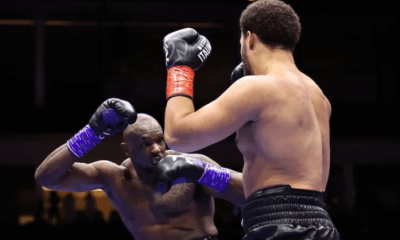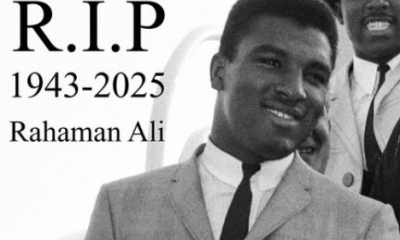Articles of 2005
Pat Putnam: Ringside observer with soul of a poet
When China entered the Korean Conflict in the fall of 1950, the Red Army came pouring across the 38th Parallel and quickly overwhelmed remnants of the United States Marine Corps at Chosin.
The massive counter-attack had been directed toward the South Korean army, which had promptly fled en masse, leaving its American allies to be slaughtered or taken prisoner. When Pat Putnam reflected on that experience late one night at the old Flame bar in Las Vegas, he described it as having been reduced to “two million Chinese and one little Irishman.”
Already wounded, Putnam, along with several hundred of his comrades, was captured and shipped off to a POW camp in Manchuria, where he spent the next 17 months surviving on a diet of maggots and rice. When he was released, at the conclusion of the hostilities, he weighed 85 lbs.
For the rest of his life he refused to darken the door of a Chinese restaurant, but he harbored even more ill-will toward the Koreans, who had abandoned him to his fate, than to his captors themselves.
Thirty-five years later, Pat was covering a boxing match at Caesars Palace when the promoter, Bob Arum, introduced him to a visiting dignitary from the South Korean Boxing Federation – “Lieutenant General Kim of the Army of the Republic of Korea”.
“Turn around,” Cpl Putnam ordered the general, “so I can see if I recognize you.”
Patrick Francis Anthony Nolan Putnam, who died on Sunday at 75, was a hard-drinking, hard-living scribe with the soul of a poet. The dean of American boxing writers, he established himself at the Miami Herald in the early 1960s, an era which coincided with the arrival in that city of a promising heavyweight named Cassius Clay.
A daily habitué of the old Fifth Street Gym in Miami Beach, Putnam covered Muhammad Ali's career from its inception and was the first to break the story of Clay's impending conversion to Islam. He should also – the truth can now be told – have been credited as the co-author of some of the young pugilist's more imaginative verse.
For a quarter-century he reigned as Sports Illustrated's boxing writer extraordinaire. He authored more than 50 cover stories for the world's preeminent sports magazine, and in 1982 he was the recipient of the Nat Fleischer Award for Distinguished Boxing Journalism.
The 1987 “Fight of the Century” between Marvelous Marvin Hagler and Ray Charles Leonard was shrouded in some controversy. Sugar Ray was returning to the ring after an absence of three years, and the medical community was divided over the question of whether, having undergone surgery for a detached retina, he should be fighting at all.
When the boxers appeared at a press conference on the eve of the fight, Arum preceded the question-and-answer session with a decree ruling out any questions about Leonard's eye. From far in the back of the room, Putnam raised his hand and was duly called upon.
“Hey, Ray,” he asked. “How many fingers am I holding up?”
The week of a big fight Putnam would hold court from his barstool – at the Galleria Bar at Caesars by day, at the Flame by night – and trainers, promoters and fellow scribes would flock to him there. After the fight he would have arranged to meet the winner, and sometimes the loser, in his hotel suite. The result would invariably be the finest and most insightful prose written about the event, and those of us committed to one-hour deadlines and quickie quotes could only read with envy.
Boxers trusted Putnam, sometimes because they erroneously assumed him to have been one of their own, but his pug's nose hadn't been acquired in the ring, or even in one of his celebrated saloon scraps. In the late 1960s he had broken nearly every bone in his body in a Long Island automobile accident and underwent a facial reconstruction. The result was the best the doctors could do with what passed for a nose.
Months after he had recovered, Putnam received a bill from the authorities demanding payment for a utility pole he had destroyed in the head-on collision. Pat reluctantly agreed to pay the money, but only on the condition that he get possession of the pole.
“That's a pretty expensive souvenir,” the man at the county clerk's office told him.
“I don't want it for a souvenir,” replied Putnam. “I just want to practice driving around it.”
At a party the night before the 1976 Sugar Bowl in New Orleans, Pat and I came upon a lively crap game under way in the hallway of a French Quarter hotel. We watched for long enough to realize that the game was crooked, and had even figured out exactly how the proprietors had rigged the proceedings. I left to get us a couple of drinks, and, when I returned, there was Pat on his knees.
Determined to beat the grifters at their own game, he was rolling the dice on the carpet.
On another occasion, Pat, Michael Katz, Angelo Dundee and I had flown from Baltimore to Miami for the 1982 Aaron Pryor-Alexis Arguello fight, extinguishing the plane's supply of Bloody Marys en route. By the time we arrived at our destination I was unsure that I could operate my rental car.
“No problem,” said Pat. “I'll drive.”
He did get us safely to our hotel. Only later did I realize that he'd gone the wrong way out of the Hertz lot, driven across a set of steel spikes, and punctured all four tires on the rental car. They were belted radials, so I drove with them that way for the rest of the weekend.
When his longtime friend and colleague Bob Waters passed away some years ago, we took a train out to the Island for the funeral. When he spotted the great man's body in repose beneath a bed of roses, Putnam vouchsafed: “Holy shit. Bob won the Kentucky Derby.”
In recent years we'd communicated mostly by telephone and e-mail. Pat had been in poor health and had given up traveling to big fights since his retirement from Sports Illustrated, but he'd kept his hand in as a frequent contributor to the boxing website
TheSweetScience.com. The final installment of his four-part series on another “Fight of the Century” – the 1910 Jack Johnson-Jim Jeffries fight in Reno – appeared the day after he died.
Pat was buried today following a funeral Mass at St John the Evangelist Church in Schenectady, New York. I'm anxious to learn whether his family will respect his final wish, which was that his tombstone read, simply, “KEEP OFF THE GRASS”.
(Special thanks to The Irish Times for permission to reprint this article.)
-

 Featured Articles4 weeks ago
Featured Articles4 weeks agoThe Hauser Report: Zayas-Garcia, Pacquiao, Usyk, and the NYSAC
-

 Featured Articles3 weeks ago
Featured Articles3 weeks agoOscar Duarte and Regis Prograis Prevail on an Action-Packed Fight Card in Chicago
-

 Featured Articles2 weeks ago
Featured Articles2 weeks agoThe Hauser Report: Cinematic and Literary Notes
-

 Book Review2 weeks ago
Book Review2 weeks agoMark Kriegel’s New Book About Mike Tyson is a Must-Read
-

 Featured Articles4 weeks ago
Featured Articles4 weeks agoRemembering Dwight Muhammad Qawi (1953-2025) and his Triumphant Return to Prison
-

 Featured Articles7 days ago
Featured Articles7 days agoMoses Itauma Continues his Rapid Rise; Steamrolls Dillian Whyte in Riyadh
-

 Featured Articles3 weeks ago
Featured Articles3 weeks agoRahaman Ali (1943-2025)
-

 Featured Articles3 weeks ago
Featured Articles3 weeks agoTop Rank Boxing is in Limbo, but that Hasn’t Benched Robert Garcia’s Up-and-Comers














